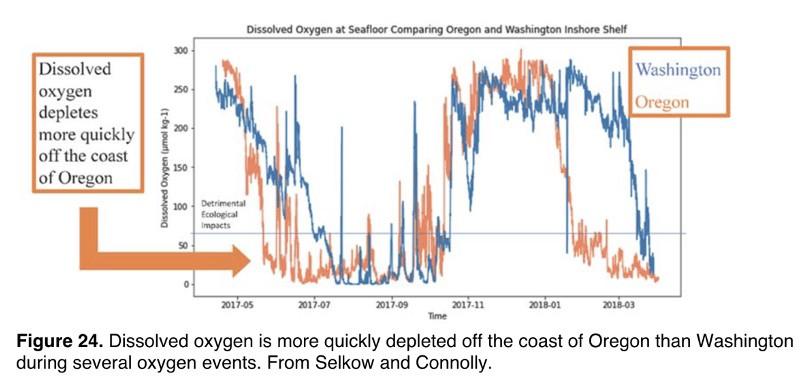
4 minute read
Multi-year Records of In-situ CO2 Flux from the OOI Coastal Arrays
Coastal Arrays In the summer of 2020 the Rutgers University Ocean Data Labs project https://datalab.marine.rutgers.edu/ worked with the Rutgers Research Internships in Ocean Science (RIOS) to support ten undergraduate students in a virtual Research Experiences for Undergraduates (REU) program. Two weeks of research methods training and Python coding instruction was followed by six weeks of independent study with a research mentor. A poster by Velasco, Eveleth and Thorson (ED004-0045) analyzed pCO2 data from the Endurance Array offshore mooring. Three years of nearly continuous data were available during 2016-2018. The seasonal cycle showed that the pCO2 concentration in water was relatively stable and near equilibrium with the air in winter, decreasing in late spring and summer (Figure 23. Shortterm minima in summer were as low as 150 uatm. Like the east coast, the mean air-sea CO2 flux was consistently negative, meaning the coastal ocean acts as a carbon sink. The annual means at the 58 Washington Offshore mooring for 2016, 2017 were 1.9 and -2.1 mol C/(m2 yr), respectively. The seasonal cycle appears to be strongly driven by non-thermal factors (on short time scales), presumably upwelling events and algal blooms. These studies, although preliminary, are among the first to use multi-year records of in-situ CO2 flux from the OOI coastal arrays, and to our knowledge the first to compare such records between the east and west coast. Dr. Eveleth’s team intends to use the rich, complementary data set available from the OOI coastal
Advertisement
Coast Impacted by Upwelling In the summer of 2020, the Rutgers University Ocean Data Labs project https://datalab.marine.rutgers.edu/ worked with the Rutgers Research Internships in Ocean Science (RIOS) to support ten undergraduate students in a virtual Research Experiences for Undergraduates (REU) program. Rutgers led two weeks of research methods training and Python coding instruction. This was followed by six weeks of independent study with one of 13 research mentors. Dr. Tom Connolly (Moss Landing Marine Labs, San Jose State Univ.) advised Andrea Selkow from Austin College (TX) on her study of dissolved oxygen (DO) off the Washington and Oregon coasts using the OOI Endurance Array. Selkow evaluated DO data from Endurance Array Surface Moorings during 2017 and 2018. She presented this work as a poster at the conclusion of her summer REU. Selkow focused on the question: Are there similarities in the dissolved oxygen concentrations off the coast of Oregon and Washington during a known low oxygen event? She also considered why there might exist differences based on the spatial variability of wind stress forcing, i.e., do the strong Oregon winds cause dissolved oxygen concentrations to be lower at the Oregon mooring compared to the Washington moorings. Finally, she reviewed the data and tried to answer whether the oxygen data were accurate or affected by biofouling. She used datasets from the OR and WA Inshore Shelf Mooring timeseries and WA Shelf Mooring timeseries

her attention on low DO observed in the summer of 2017. While Barth et al. (2018) presented a report on these data for one event in July 2017, she expanded the analysis to include the Washington shelf and inshore moorings. She plotted time series data and used cruise data to validate these time series. While overall seasonal trends in DO were similar, she found dissolved oxygen is routinely more quickly depleted off the coast of Oregon than Washington during a low oxygen event (Figure 24). She also looked at the cross-shelf variability in DO time series and found dissolved oxygen is more quickly depleted at the shelf mooring than at the inshore shelf mooring. Upwelling is known to drive the low oxygen events and she inferred that the weaker southward winds over the Washington shelf may be why DO decreases at a slower rate off Washington than Oregon.
While overall seasonal trends in DO were similar, she found dissolved oxygen is routinely more quickly depleted off the coast of Oregon than Washington during a low oxygen event (Figure 24). She also looked at the crossshelf variability in DO time series and found dissolved oxygen is more quickly depleted at the shelf mooring than at the inshore shelf mooring. Upwelling is known to drive the low oxygen events and she inferred that the weaker southward winds over the Washington shelf may be why DO decreases at a slower rate off Washington than
Oregon.Barth, J.A., J.P. Fram, E.P. Dever, C.M. Risien, C.E. Wingard, R.W. Collier, and T.D.
Kearney. 2018. Warm blobs, low-oxygen events, and an eclipse: The Ocean
Observatories Initiative Endurance Array captures them all. Oceanography 31(1):90–97, https://doi.org/10.5670/oceanog.2018.114.
Selkow, A. and T. Connelly. Low Dissolved Oxygen off Washington and Oregon
Coast Impacted by Upwelling in 2017, https://datalab.marine.rutgers.edu/wp-content/uploads/2020/07/AndreaREU2020-P oster.pdf , Accessed 13 Jan 2021.










